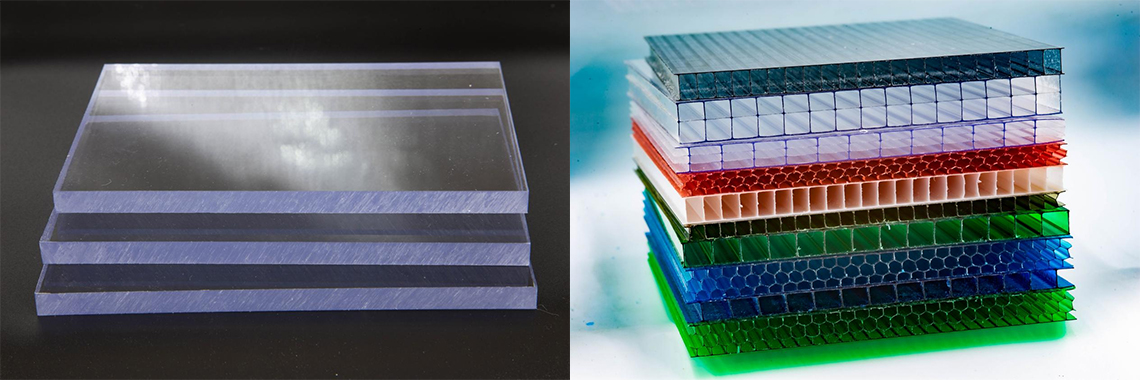Solid vs. Hollow Polycarbonate Sheets: Key Differences
Polycarbonate sheets are available in two main types: solid and hollow. Each type has distinct characteristics that make them suitable for different applications. Here's a breakdown of the key differences between solid and hollow polycarbonate sheets:

1. Structure
- Solid Polycarbonate Sheets: These sheets are entirely solid, with a uniform structure throughout. They resemble glass or acrylic sheets in their appearance but offer significantly greater impact resistance.
- Hollow Polycarbonate Sheets: These sheets have a multi-wall structure, meaning they consist of multiple layers with hollow spaces (or air pockets) between them. This gives them a lightweight, insulated design that is not found in solid sheets.
2. Strength and Durability
- Solid Polycarbonate Sheets: Known for their extreme durability, solid polycarbonate sheets are virtually unbreakable. They can withstand heavy impacts, making them ideal for applications where strength and safety are critical, such as in security glazing or protective barriers.
- Hollow Polycarbonate Sheets: While still strong, hollow polycarbonate sheets are not as impact-resistant as their solid counterparts. However, they are durable enough for applications like roofing and cladding, where the emphasis is more on insulation and weight than on maximum impact resistance.
3. Weight
- Solid Polycarbonate Sheets: These sheets are heavier due to their solid structure. While they are lighter than glass, they are still significantly denser than hollow polycarbonate sheets.
- Hollow Polycarbonate Sheets: The air pockets within hollow polycarbonate sheets make them much lighter. This reduced weight makes them easier to handle and install, particularly in large-scale projects such as roofing.
4. Insulation Properties
- Solid Polycarbonate Sheets: These sheets offer limited thermal insulation compared to hollow sheets. While they do provide some insulation, they are more commonly chosen for their strength and clarity rather than their insulating properties.
- Hollow Polycarbonate Sheets: The multi-wall structure of hollow polycarbonate sheets enhances their thermal insulation capabilities. The air pockets act as barriers to heat transfer, making them ideal for applications where energy efficiency is a priority, such as in greenhouses or skylights.
5. Transparency and Clarity
- Solid Polycarbonate Sheets: These sheets offer excellent optical clarity, similar to glass. They are ideal for applications where transparency is crucial, such as in windows, signage, and protective barriers.
- Hollow Polycarbonate Sheets: While hollow sheets allow light to pass through, their clarity is not as high as solid sheets. The multi-wall design can slightly diffuse light, which is often beneficial in applications like roofing, where diffused light is preferred.
6. Applications
- Solid Polycarbonate Sheets: Used in high-impact applications, such as security glazing, machine guards, and optical lenses. Their combination of strength, clarity, and durability makes them suitable for environments where safety and visibility are paramount.
- Hollow Polycarbonate Sheets: Commonly used in construction for roofing, cladding, and partitions. Their lightweight and insulating properties make them ideal for large installations where energy efficiency and ease of installation are important.
7. Cost
- Solid Polycarbonate Sheets: Generally more expensive due to their higher material density and superior impact resistance. The cost reflects the premium nature of these sheets in terms of durability and clarity.
- Hollow Polycarbonate Sheets: Typically more affordable than solid sheets, making them a cost-effective choice for applications requiring insulation and lightweight materials without the need for extreme impact resistance.
Conclusion
The choice between solid and hollow polycarbonate sheets depends on the specific needs of your project. Solid polycarbonate sheets are best suited for applications requiring maximum strength and clarity, while hollow polycarbonate sheets excel in providing insulation and lightweight solutions for construction purposes. Understanding these differences will help you select the right type of polycarbonate sheet for your needs.Learn more


The PC hollow sheet supplier in Ahmedabad are an excellent choice for various applications due to their durability, lightweight nature, and excellent insulation properties. These sheets are ideal for roofing, partitions, and greenhouse construction, providing great strength while remaining easy to handle. PC Hollow Sheets offer high impact resistance and UV protection, making them long-lasting in different weather conditions. Whether for industrial or residential use, PC Hollow Sheets ensure a reliable and cost-effective solution. Highly recommended for those seeking a versatile and efficient material.
ReplyDelete